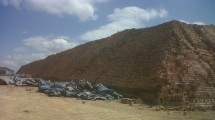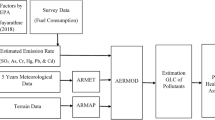Abstract
This paper presents monitoring results of daily brick kiln stack emission and the derived emission factors. Emission of individual air pollutant varied significantly during a firing batch (7 days) and between kilns. Average emission factors per 1,000 bricks were 6.35–12.3 kg of CO, 0.52–5.9 kg of SO2 and 0.64–1.4 kg of particulate matter (PM). PM emission size distribution in the stack plume was determined using a modified cascade impactor. Obtained emission factors and PM size distribution data were used in simulation study using the Industrial Source Complex Short-Term (ISCST3) dispersion model. The model performance was successfully evaluated for the local conditions using the simultaneous ambient monitoring data in 2006 and 2007. SO2 was the most critical pollutant, exceeding the hourly National Ambient Air Quality Standards over 63 km2 out of the 100-km2 modelled domain in the base case. Impacts of different emission scenarios on the ambient air quality (SO2, PM, CO, PM dry deposition flux) were assessed.
Similar content being viewed by others
References
AIRPET-VN, Asian Regional Air Pollution Research Network (2007). Regional program on environmental and technology (ARRPET): Improving air quality in Vietnam, Annual report 2006, submitted to AIT- Sida.
Blackman, A. (2000). Informal sector pollution control: What policy options do we have? World Development, 28(12), 2067–2082.
Brick Industry Association (2006). Technical notes on brick construction. Manufacturing of brick. http://www.bia.org/BIA/technotes/t9.htm.
CAI-Asia (2008). Clean air initiative for Asia cities. Clean brick making technology—success of VSBK in Kathmandu. http://www.cleanairnet.org/caiasia/1412/article-70695.html.
Co, H. X., Dung, N. T., Le, H. A., An, D. A., Chinh, K. V., & Kim Oanh, N. T. (2009). Integrated management strategies for brick kiln emission reduction. International Journal of Environmental Studies, 66(1), 113–124.
Dung, B. T., & Son, T. T. (2004). Low cost roads working paper no. 16: Clay brick paving investigations in Vietnam. MoT, TEDI, Intech Associates. http://www.transport-links.org/transport_links/filearea/documentstore/312_Working%20Paper16b.pdf.
FAO (1993). Regional Wood Energy Development Programme in Asia. Status and development issues of the brick industry in Asia. Bangkok: FAO.
Ferdausi, S. A., Vaideeswaran, S., & Akbar, S. (2008). Greening brick making industries in Bangladesh. Presentations at the Better Air Quality Conference, Nov. 12–14, 2008, Bangkok, Thailand.
General Statistics Office (2005). Statistical yearbook of Vietnam 2005. Statistical, Hanoi.
Kim Oanh, N. T., Upadhyay, N., Zhuang, Y. H., Hao, Z. P.,Murthy, D. V. S., Lestari, P., Villarin, J. T., et al. (2006). Particulate air pollution in six Asian cities: Spatial and temporal distributions, and associated sources. Atmospheric Environment, 40, 3367–3380.
Le, H. A. (2007). Integrated monitoring—modeling tool to develop air quality management strategies for a brick kiln manufacturing community in Vietnam. AIT Master thesis, EV-07-14, Asian Institute of Technology, Bangkok, Thailand.
MONRE, Ministry of Natural Resources and Environment of Vietnam (2005). Vietnam environmental standards. Hanoi: MONRE.
RERIC, Regional Energy Resources Information Center (2003). Small and medium scale industries in Asia: Energy and environment, brick and ceramic sectors. Bangkok: Asian Institute of Technology.
Singh, A. L., & Asgher, M. S. (2005). Impact of brick kilns on land use/landcover changes around Aligarh city, India. The Journal of Habitat International, 29, 591–602.
US EPA (1986). Modified method 5 (method 0010) sampling train, revision 0, September 1986. Washington, DC: US EPA.
US EPA (1995). User’s guide for the Industrial Source (ISC3) Dispersion Model. Vol. I, user instructions. Washington, DC: US EPA.
US EPA (1999). PCRAMMET user’s guider. Washington, DC: US EPA.
Wark, K., Warner, C. F., & Davis, W. T. (1998). Air pollution: Its origin and control, 3rd edn. New York: Harper Collins.
Zhang, Z. (1997). Energy efficiency and environmental pollution of brick making in China. Energy, 22(1), 33–42.
Author information
Authors and Affiliations
Corresponding author
Rights and permissions
About this article
Cite this article
Le, H.A., Oanh, N.T.K. Integrated assessment of brick kiln emission impacts on air quality. Environ Monit Assess 171, 381–394 (2010). https://doi.org/10.1007/s10661-009-1285-y
Received:
Accepted:
Published:
Issue Date:
DOI: https://doi.org/10.1007/s10661-009-1285-y




